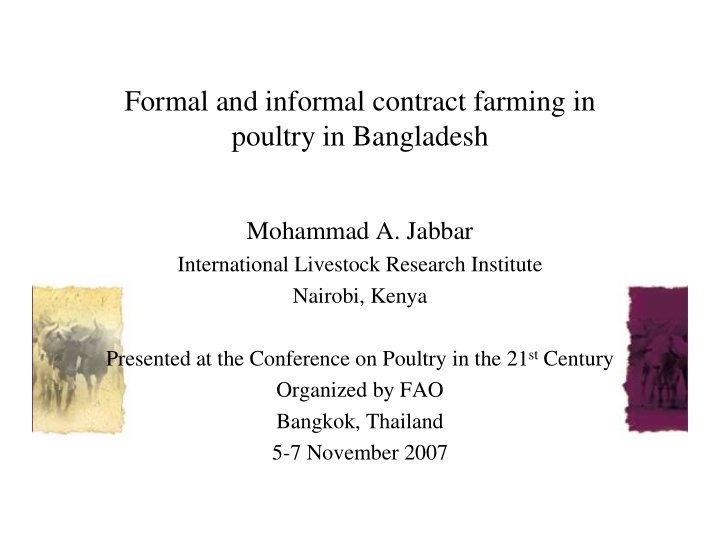



Formal and informal contract farming in poultry in Bangladesh Mohammad A. Jabbar International Livestock Research Institute Nairobi, Kenya Presented at the Conference on Poultry in the 21 st Century Organized by FAO Bangkok, Thailand 5-7 November 2007
Classifying types of contract farming Criteria used for classification may include: • scope, products or services covered • formation, enforcement and monitoring mechanism of contract agreement including dispute settlement • sharing of benefits, risks, responsibilities and liabilities • scope for participation of smallholders
Contract farming types in Bangladesh poultry • Production-marketing contracts – Supply of inputs and services by integrators – Purchase of products – Sharing of risks and benefits – Written contracts with producers • Input marketing contracts – Only supply of inputs and services by hatcheries and feed industries – Risks not shared by input suppliers – Written contracts with input traders who have secondary contracts with producers • Output marketing contracts – Forward purchase of products from producers – Risks borne by producers – Generally unwritten contracts
Production-marketing contract operations Aftab Ltd Biman BRAC Year established 1992 1997 2003 Products covered Broiler, Breeder stock Broiler Broiler Vertical integration Yes Partial Partial Input supply Credit till 2003, then cash On credit On credit Output purchase Market price plus margin Fixed price Fixed price Production risk 100%producer with 100% 100% insurance producer producer Price risk Shared Producer Producer N of producers 350 and 122 25 215 Batch size 1500-2500 1000-5000 500-2000 Av 1800 Av 2500 Av 800
Input marketing contract operations Kazi Farms Paragon poultry Nourish Feeds Year established 1996 ? ? Inputs covered DOCs, feeds DOCs, feeds DOCs, feeds Other services Vet service free, Vet service free, Vet service free, drugs at cost drugs at cost drugs at cost Help product sale Help product sale Help product sale Mode of payment Cash , advance Cash, advance Cash, advance Production risk 100% producer 100% producer 100% producer Price risk 100% producer 100% producer 100% producer N of trader agents 600 205 160 Volume of business 1.5 mil DOCs 0.4 mil DOCs 0.3 mil DOCs per week 3500 t feeds 1000 t feeds 2300 t feeds
Output marketing contracts • Wholesellers and stockists of broiler and eggs in Dhaka forward purchase from producers directly or through agents by making advance payment (can be considered tied loan) • Price supposed to be prevailing market price at time of delivery but usually less due to buyer cartels • Production and price risks borne by producers • Main advantage is access to cash for input purchase when access to formal credit may be difficult or costly • Practiced widely throughout the country as for any other market oriented commodity
Implications of contract types : Production- marketing contracts • About 600 farm households are involved covering a tiny share of broiler market • Main advantage assured outlet for product, other conditions variable among operators. Aftab’s insurance scheme has something to recommend it for wider applicatio b • Operators operate in different geographical areas so there is no competition as such as producers can’t choose between options • BRAC’s contractees include smallest farms, Aftab’s breeder stock farmers are relatively rick • Potential risk of Avian Influenza may limit expansion of this type of contract and also may also lead to emergence of terms more favourable to integrators.
Implications of contract types : Input marketing contracts • A dual structure is emerging in the input industry: few large operators deriving economies of scale and controlling large market share, may push smaller operators out of business if policy distortions (cheap credit, import subsidy, tax relief…) continue to favour large operators • Competition in the industry will be beneficial for both suppliers of inputs, input traders and producers as it will keep prices low, improve product quality and services • Hatchery industry is underinvested, capacity lower than demand, so advance order with advance payments at higher prices are required to maintain production cycle by producers • Dependence on imported raw material and uncertainty with electric supply are major bottlenecks for expansion of the industry
Implications of contract types : Input marketing contracts • Asymmetric information on supply, demand and prices and market power of buyers derived from these are main problems for producers under this type of contract • Easier access to formal credit at interest rates and terms comparable to large operators will increase bargaining power of producers • Forward purchase contracts will continue to play important roles in the poultry sector but expansion of formal contracts and appropriate policies with respect to formal credit, input industry and prices will be needed to make it beneficial for smallholder producers.
Cause of dropping out of poultry ( survey of 140 drop outs in last 5 yrs ) Reason for drop out % sample Input price higher than output price 81 Low output price 73 High price of day old chicks 63 High mortality 47 Shortage of capital 60 DOCs- poor quality, low productivity 51 -Untimely supply 33 -Inadequate supply 31 Moved into other business 29 Disagreement among family members/partners 26
Potential role of formal contracts • Uncertainty of product price, inconsistency between input and product price, shortage of capital and problems with supply of day old chicks (poor quality and productivity, inadequate supply, untimely supply…) are major problems faced by producers. • Unless formal contract arrangements can mitigate some of these, producers will remain vulnerable to the forward purchase contractors , who are basically money lenders.
Thank you
Recommend
More recommend